Gas-In-Place Estimate for Potential Gas Hydrate Concentrated Zone in the Kumano Basin, Nankai Trough Forearc, Japan
Abstract
:1. Introduction
2. Geologic Setting
2.1. Tectonic Environment
2.2. Kumano Basin Evolution
3. Materials and Methods
3.1. Borehole Data
3.2. Seismic Data
3.2.1. Seismic Acquisition
3.2.2. Seismic Processing
3.2.3. Data Interpretation
3.3. Gas-in-Place (GIP) Estimate
4. Results and Discussion
4.1. Drilling Data Summary
4.2. Seismic Mapping and Interpretation
4.2.1. Bottom Simulating Reflections (BSRs)
4.2.2. Seismic Evidence for Gas Source and Migration Pathways into the MHCZs
4.2.3. Seismic Evidence for Gas and GH Traps
4.3. Volumetric Gas in Place Estimate
5. Conclusions
Supplementary Materials
Acknowledgments
Author Contributions
Conflicts of Interest
References
- Buffett, B.; Archer, D. Global inventory of methane clathrates: Sensitivity to changes in the deep ocean. Earth Planet. Sci. Lett. 2004, 227, 185–199. [Google Scholar] [CrossRef]
- Boswell, R. Is gas hydrate energy within reach? Science 2009, 325, 957–958. [Google Scholar] [CrossRef] [PubMed]
- Burwicz, E.B.; Rüpke, L.H.; Wallman, K. Estimation of the global amount of submarine gas hydrates formed vial microbial methane formation based on numerical reaction-transport modeling and a novel parameterization of Holocene sedimentation. Geochim. Cosmochim. Acta 2011, 75, 4562–4576. [Google Scholar] [CrossRef] [Green Version]
- Collett, T.S. Energy resource potential of natural gas hydrates. Am. Assoc. Pet. Geol. Bull. 2002, 86, 1971–1992. [Google Scholar] [CrossRef]
- Collett, T.S.; Johnson, A.; Knapp, C.; Boswell, R. Natural gas hydrates—A review. In Natural Gas Hydrates—Energy Resource Potential and Associated Geologic Hazards; Collett, T., Jonhson, A., Knapp, C., Boswell, R., Eds.; AAPG Memoir 89; AAPG: Tulsa, OK, USA, 2009. [Google Scholar]
- Boswell, R.; Saeki, T. Motivations for the geophysical investigation of gas hydrates. In Geophysical Characterization of Gas Hydrate; Riedel, M., Willoughby, E., Chopra, S., Eds.; SEG Geophysical Developments Series; Society of Exploration Geophysicists: Tulsa, OK, USA, 2010; Volume 14, pp. 23–32. [Google Scholar]
- Riedel, M.; Collett, T.S.; Kumar, P.; Sathe, A.V.; Cook, A. Seismic imaging of a fractured gas hydrate system in the Krishna-Godavari Basin offshore India. Mar. Pet. Geol. 2010, 27, 1476–1493. [Google Scholar] [CrossRef]
- Tamaki, M.; Suzuki, K.; Fujii, T.; Sato, A. Prediction and validation of gas hydrate saturation distribution in the eastern Nankai Trough, Japan: Geostatistical approach integrating well-log and 3D seismic data. Interpretation 2016, 4, SA83–SA94. [Google Scholar] [CrossRef]
- Kroeger, K.F.; Crutchley, G.J.; Hill, M.G.; Pecher, I.A. Potential for gas hydrate formation at the northwest New Zealand shelf margin—New insights from seismic reflection data and petroleum systems modelling. Mar. Pet. Geol. 2017, 83, 215–230. [Google Scholar] [CrossRef]
- Burwicz, E.; Reichel, T.; Wallmann, K.; Rottke, W.; Haeckel, M.; Hensen, C. 3-D basin-scale reconstruction of natural gas hydrate system of the Green Canyon, Gulf of Mexico. Geochem. Geophys. Geosyst. 2017, 18, 1959–1985. [Google Scholar] [CrossRef]
- Hillman, J.I.T.; Cook, A.E.; Sawyer, D.E.; Kucuk, H.M.; Goldberg, D.S. The character and amplitude of ‘discontinuous’ bottom simulating reflections in marine seismic data. Earth Planet. Sci. Lett. 2017, 459, 157–169. [Google Scholar] [CrossRef]
- Santamarina, J.C.; Dai, S.; Terzariol, M.; Jang, J.; Waite, W.F.; Winters, W.J.; Nagao, J.; Yoneda, J.; Konno, Y.; Fujii, T.; et al. Hydro-bio-geomechanical properties of hydrate-bearing sediments from Nankai Trough. Mar. Pet. Geol. 2015, 66, 1–17. [Google Scholar] [CrossRef]
- Nagakubo, S. Methane hydrate as a domestic energy resource: Japan’s methane hydrate R&D program. J. Geogr. 2009, 118, 758–775. [Google Scholar] [CrossRef]
- Fujii, T.; Noguchi, S.; Takayama, T.; Suzuki, K.; Yamamoto, K.; Saeki, T. Site selection and formation evaluation at the 1st offshore methane hydrate production test site in the eastern Nankai Trough, Japan. In Proceedings of the 75th EAGE Conference & Exhibition Incorporating SPE EUROPEC, London, UK, 10–13 June 2013. [Google Scholar]
- Fujii, T.; Suzuki, K.; Takayama, T.; Tamaki, M.; Komatsu, Y.; Konno, Y.; Yoneda, J.; Yamato, K.; Nagao, J. Geological setting and characterization of a methane hydrate reservoir distributed at the first offshore production test site on the Daini-Atsumi Knoll in the eastern Nankai Trough, Japan. Mar. Pet. Geol. 2015, 66, 310–322. [Google Scholar] [CrossRef]
- Booth, J.S.; Winters, W.J.; Dillon, W.P.; Clennell, M.B.; Rowe, M.M. Major occurrences and reservoir concepts of marine clathrates hydrates: Implications of field evidence. In Gas Hydrates: Relevance to World Margin Stability and Climate Change; Henriet, J.-P., Mienert, J., Eds.; Geological Society: London, UK, 1998; Volume 137, pp. 113–127. [Google Scholar]
- Kastner, M.; Solomon, E.A.; Harris, R.N.; Torres, M.E. Fluid origins, thermal regimes, and fluid and solute fluxes in the forearc of subduction zones. Del. Mar. Geol. 2014, 7, 671–733. [Google Scholar] [CrossRef]
- Yamada, Y.; Baba, K.; Miyakawa, A.; Matsuoka, T. Granular experiments of thrust wedges: Insights relevant to methane hydrate exploration at the Nankai accretionary prism. Mar. Pet. Geol. 2014, 51, 34–48. [Google Scholar] [CrossRef] [Green Version]
- Auguy, C.; Calves, G.; Calderon, Y.; Brusset, S. Seismic evidence of gas hydrates, multiple BSRs and fluid flow offshore Tumbes Basin, Peru. Mar. Geophys. Res. 2017, 38, 1–15. [Google Scholar] [CrossRef]
- Saffer, D.M.; Tobin, H.J. Hydrogeology and mechanics of subduction zone forearcs: Fluid flow and pore pressure. Annu. Rev. Earth Planet. Sci. 2011, 39, 157–186. [Google Scholar] [CrossRef]
- Ando, M. Source mechanism and tectonic significance of historical earthquakes along the Nankai Trough, Japan. Tectonophysics 1975, 27, 119–140. [Google Scholar] [CrossRef]
- Baba, T.; Cummins, P.R. Contiguous rupture areas of two Nankai Trough earthquakes revealed by high resolution tsunami waveform inversion. Geophys. Res. Lett. 2005, 32, L08305. [Google Scholar] [CrossRef]
- Fischer, D.; Mogollon, J.M.; Strasser, M.; Pape, T.; Bohrmann, G.; Fekete, N.; Spiess, V.; Kasten, S. Subduction zone earthquake as potential trigger of submarine hydrocarbon seepage. Nat. Geosci. 2013, 6, 647–651. [Google Scholar] [CrossRef]
- Seno, T.; Stein, S.; Gripp, A.E. A model for the motion of the Philippine Sea plate consistent with NUVEL-1 and geological data. J. Geophys. Res. 1993, 98, 17941–17948. [Google Scholar] [CrossRef]
- Taira, A.; Curewitz, D.; Hashimoto, T.; Ibusuki, A.; Kuramoto, S.I.; Okano, T.; Tanaka, H. Nankai Trough Seismogenic Site Survey: Kumano Basin Seismic Survey, Philippine Sea, Offshore Kii Peninsula, Japan. In CDEX Technical Report; Taira, A., Curewitz, D., Eds.; Japan Agency for Marine-Earth Science and Technology: Yokosuka, Japan, 2005; Volume 1, p. 64. ISSN 1880-0777. [Google Scholar]
- Strasser, M.; Dugan, B.; Kanagawa, K.; Moore, G.F.; Toczko, S.; Maeda, L. The Expedition 338 Scientists. In Proceedings of the Integrated Ocean Drilling Program (IODP), Yokohama, Japan, 1 October–13 January 2013; Volume 338. [Google Scholar]
- Moore, G.F.; Bangs, N.L.; Taira, A.; Kuramoto, S.; Pangborn, S.; Tobin, H.J. Three-dimensional splay fault geometry and implications for tsunami generation. Science 2007, 318, 1128–1131. [Google Scholar] [CrossRef] [PubMed]
- Gulick, S.P.S.; Bangs, N.L.B.; Moore, G.F.; Ashi, J.; Martin, K.M.; Sawyer, D.S.; Tobin, H.J.; Kuramoto, S.; Taira, A. Rapid forearc basin uplift and megasplay fault development from 3D seismic images of Nankai Margin off Kii Peninsula, Japan. Earth Planet. Sci. Lett. 2010, 414, 164–175. [Google Scholar] [CrossRef]
- Moore, G.F.; Boston, B.B.; Strasser, M.; Underwood, M.B.; Ratliff, R.A. Evolution of tectono-sedimentary systems in the Kumano Basin, Nankai Trough forearc. Mar. Pet. Geol. 2015, 67, 604–616. [Google Scholar] [CrossRef]
- Moore, G.F.; Boston, B.B.; Sacks, A.F.; Saffer, D.M. Analysis of normal fault populations in the Kumano Forearc Basin, Nankai Trough, Japan: 1. Multiple orientations and generations of faults from 3D coherency mapping. Geochem. Geophys. Geosys. 2013, 14, 1989–2002. [Google Scholar] [CrossRef]
- Hayman, N.W.; Byrne, T.B.; McNeill, L.C.; Kanagawa, K.; Kanamatsu, T.; Browne, C.M.; Schleicher, A.M.; Huftile, G.J. Structural evolution of an inner accretionary wedge and forearc basin initiation, Nankai margin, Japan. Earth Planet. Sci. Lett. 2012, 353–354, 163–172. [Google Scholar] [CrossRef]
- Ashi, J.; Tokuyama, H.; Taira, A. Distribution of methane hydrate BSRs and its implication for the prism growth in the Nankai Trough. Mar. Geol. 2002, 187, 177–191. [Google Scholar] [CrossRef]
- Morita, S.; Ashi, J.; Aoike, K.; Kuramoto, S. Evolution of Kumano Basin and Sources of Clastic Ejecta and Pore Fluid in Kumano Mud Volcanoes, Eastern Nanaki Trough. In Proceedings of the International Symposium on Methane Hydrates and Fluid Flow in Upper Accretionary Prisms (Prism Fluid 2004), Kyoto, Japan, 6 February–3 April 2004. [Google Scholar]
- Moore, G.F.; Strasser, M. Large mass transport deposits in Kumano Basin, Nankai Trough, Japan. In Submarine Mass Movements and Their Consequences; Lamarche, G., Mountjoy, J., Bull, S., Hubble, T., Krastel, S., Lane, E., Micallef, A., Moscardelli, L., Mueller, C., Pecher, I., et al., Eds.; Springer: Berlin/Heidelberg, Germany, 2015; pp. 371–379. [Google Scholar]
- Fergusson, C.L. Provenance of Miocene-Pleistocene Turbidite Sands and Sandstones, Nankai Trough, Ocean Drilling Program Leg 190. 2003. Available online: http://www-odp.tamu.edu/publications/190196SR/205/205_.htm (accessed on 14 November 2003).
- Clift, P.D.; Carter, A.; Nicholson, U.; Masago, H. Zircon and apatite thermochronology of the Nankai Trough accretionary prism and trench, Japan: Sediment transport in an active and collisional margin setting. Tectonics 2013, 32, 377–395. [Google Scholar] [CrossRef]
- Usman, M.O.; Masago, H.; Winkler, W.; Strasser, M. Mid-Quaternary decoupling of sediment routing in the Nankai Forearc revealed by provenance analysis of tubiditic sands. Int. J. Earth Sci. 2014, 103, 1141–1161. [Google Scholar] [CrossRef]
- Buchs, D.M.; Cukur, D.; Masago, H.; Garbe-Schonberg, D. Sediment flow routing during formation of forearc basins: Constraints from integrated analysis of detrital pyroxenes and stratigraphy in the Kumano Basin, Japan. Earth Planet. Sci. Lett. 2015, 414, 164–175. [Google Scholar] [CrossRef]
- Takano, O.; Itoh, Y.; Kusumoto, S. Variations in forearc basin configuration and basin filling depositional systems as a function of trench slope break development and strike-slip movement: Examples from the Cenozoic Ishikari-Sanriku-Oki and Tokai-Oki-Kumano-Nada forearc basins, Japan. In Mechanism of Sedimentary Basin Formation-Multidisciplinary Approach on Active Plate Margins; InTechOpen: Rijeka, Croatia, 2013; Chapter 11. [Google Scholar]
- Saffer, D.; McNeill, L.; Byrne, T.; Araki, E.; Toczko, S.; Eguchi, N.; Takahashi, K. Expedition 319 Scientists. Site C0009. In Proceedings of the Integrated Ocean Drilling Program; Integrated Ocean Drilling Program Management International, Inc.: Tokyo, Japan, 2010; Volume 319. [Google Scholar]
- Ramirez, S.G.; Gulick, S.P.S.; Hayman, N.W. Early sedimentation and deformation in the Kumano forearc basin linked with Nankai accretionary prism evolution, southwest Japan. Geochem. Geophys. Geosyst. 2015, 16, 1616–1633. [Google Scholar] [CrossRef]
- Fujii, T.; Aung, T.T.; Wada, N.; Komatsu, Y.; Suzuko, K.; Ukita, T.; Wygrala, B.; Fuchs, T.; Rottke, W.; Egawa, K. Modeling gas hydrate petroleum systems of the Pleistocene turbidic sedimentary sequences of the Daini-Atsumi area, eastern Nankai Trough, Japan. Interpretation 2016, 4, SA95–SA111. [Google Scholar] [CrossRef]
- Fujii, T.; Saeki, T.; Kobayashi, T.; Inamori, T.; Hayashi, M.; Takano, O.; Takayama, T.; Kawasaki, T.; Nagakubo, S.; Nakamizu, M.; et al. Resource assessment of methane hydrate by applying probabilistic approach in the eastern Nankai Trough, Japan (English abstract). J. Geogr. 2009, 118, 814–834. [Google Scholar] [CrossRef]
- Takano, O.; Fujii, T.; Saeki, T.; Shimoda, N.; Noguchi, S.; Nishimura, M.; Takayama, T.; Tsuji, T. Applications of sedimentological methodology to the methane-hydrate exploration project in the eastern Nankai Trough area. J. Jpn. Assoc. Petroleum Technol. 2010, 75, 30–41. [Google Scholar] [CrossRef]
- Johnson, J.E.; Phillips, S.C.; Torres, M.E.; Piñero, E.; Rose, K.K.; Giosan, L. Influence of total organic carbon deposition on the inventory of gas hydrate in the Indian continental margins. Mar. Pet. Geol. 2014, 58, 406–424. [Google Scholar] [CrossRef]
- Moore, G.F.; Park, J.-O.; Bangs, N.L.; Gulick, S.P.; Tobin, H.J.; Nakamura, Y.; Saito, S.; Tsuji, T.; Yoro, T.; Tanaka, H.; et al. Structural and seismic stratigraphic framework of the NanTroSEIZE Stage 1 transect. In Proceedings of the Integrated Ocean Drilling Program; Kinoshita, M., Tobin, H., Ashi, J., Kimura, G., Lallemant, S., Screaton, E.J., Curewitz, D., Masago, H., Moe, K.T., Eds.; The Expedition 314/315/316 Scientists; Integrated Ocean Drilling Program Management International, Inc.: College Station, TX, USA, 2009. [Google Scholar]
- Boswell, R.; Saeki, T.; Shipp, C.; Frye, M.; Shedd, B.; Collett, T.; Shelander, D.; McConnel, D. Prospecting for Gas Hydrate Resources. Department of Energy, FITI Methane Hydrate Newsletter. Interpreation 2014, 14, 9–13. [Google Scholar]
- Saeki, T.; Fujii, T.; Inamori, T.; Kobayashi, T.; Hayashi, M.; Nagakubo, S.; Takano, O. Extraction of methane hydrate concentrated zone for resource assessment in the eastern Nankai Trough, Japan. In Proceedings of the Offshore Technology Conference, Houston, TX, USA, 5–8 May 2008. [Google Scholar]
- Tsuji, Y.; Namikawa, T.; Fujii, M.; Hayashi, R.; Kitamura, M.; Nakamizu, K.; Ohbi, T.; Saeki, K.; Yamamoto, T.; Inamori, N.; et al. Methane hydrate occurrence and distribution in the eastern Nankai Trough, Japan: Findings of the Tokai-oki to Kumano-nada methane hydrate drilling program. In Natural Gas Hydrates—Energy Resource Potential and Associated Geologic Hazards; Collett, T., Jonhson, A., Knapp, C., Boswell, R., Eds.; AAPG Memoir 89; AAPG: Tulsa, OK, USA, 2009. [Google Scholar]
- Spence, G.D.; Haacke, R.R.; Hyndman, R.D. Seismic indicators of Natural Gas Hydrate and underlying free gas. In Geophysical Characterization of Gas Hydrates; Riedel, M., Willoughby, E.C., Chopra, S., Eds.; Society of Exploration Geophysicists: Tulsa, OK, USA, 2010; pp. 39–71. [Google Scholar]
- Taladay, K.T.; Moore, G.F. Concentrated Gas Hydrate Deposits in the Kumano Forearc Basin, Nankai Trough, Japan. Fire in the Ice 2015, 15, 1–4. Available online: https://www.netl.doe.gov/File%20Library/Research/Oil-Gas/methane%20hydrates/MHNews_2015_April.pdf (accessed on 15 September 2015).
- Wessel, P.; Smith, W.H.F.; Scharroo, R.; Luis, J.F.; Wobbe, F. Generic mapping tools: Improved version released. EOS Trans. Am. Geophys. Union 2013, 94, 409–410. [Google Scholar] [CrossRef]
- Fujii, T.; Saeki, T.; Kobayashi, T.; Inamori, T.; Hayashi, M.; Takano, O.; Takayama, T.; Kawasaki, T.; Nagakubo, S.; Nakamizu, M.; et al. Japan Oil, Gas and Metals National Corporation (JOGMEC) Resource Assessment of Methane Hydrate in the Eastern Nankai Trough, Japan. In Proceedings of the Offshore Technology Conference, Houston, TX, USA, 5–8 May 2008. [Google Scholar]
- Uchida, T.; Hirano, T.; Ebinuma, T.; Narita, H.; Gohara, K.; Mae, S.; Matsumoto, R. Raman spectroscopic determination of hydrate number of methane hydrates. AIChE J. 1999, 45, 2641–2645. [Google Scholar] [CrossRef]
- Bahk, J.-J.; Kim, D.-H.; Chun, J.-H.; Son, B.-K.; Kim, J-H.; Ryu, B.-J.; Torres, M.E.; Riedel, M.; Schultheiss, P. Gas hydrate occurrences and their relation to host sediment properties: Results from Second Ulleung Basin gas hydrate drilling expedition, East Sea. Mar. Pet. Geol. 2013, 47, 21–29. [Google Scholar] [CrossRef]
- Bahk, J.-J.; Kim, G.-Y.; Chun, J.-H.; Kim, J.-H.; Lee, J.Y.; Ryu, B.-J.; Lee, J.-H.; Son, B.-K. Characterization of gas hydrate reservoirs by integration of core and log data in the Ulleung Basin, East Sea. Mar. Pet. Geol. 2013, 47, 30–42. [Google Scholar] [CrossRef]
- Doan, M.-L.; Henry, P.; Conin, M.; Wiersberg, T.; Boutt, D.; Buchs, D.; Saffer, D.; McNeill, L.C.; Cukur, D.; Lin, W. Quantification of free gas in the Kumano fore-arc basin detected from borehole physical properties: IODP NanTroSEIZE drilling Site C0009. Geochem. Geophys. Geosyst. 2011, 12, Q0AD06. [Google Scholar] [CrossRef]
- Harris, R.N.; Schmidt-Schierhorn, F.; Spinelli, G. Heat Flow along the NanTroSEIZE transect: Results from IODP Expeditions 315 and 316 offshore the Kii Peninsula, Japan. Geochem. Geophys. Geosyt. 2011, 12, GC003593. [Google Scholar] [CrossRef]
- Miyakawa, A.; Saito, S.; Yamada, Y.; Tomaru, H.; Kinoshita, M.; Tsuji, T. Gas hydrate saturation at Site C0002, IODP Expeditions 314 and 315, in the Kumano Basin, Nankai Trough. Isl. Arc 2014, 23, 142–156. [Google Scholar] [CrossRef]
- Malinverno, A.; Goldberg, D.S. Testing short-term migration of microbial methane as a hydrate formation mechanism: Results from Andaman Sea and Kumano Basin drill sites and global implications. Earth Planet. Sci. Lett. 2015, 422, 105–114. [Google Scholar] [CrossRef]
- Jia, J.; Tsuji, T.; Matsuoka, T. Gas hydrate saturation and distribution in the Kumano Forearc Basin of the Nankai Trough. EG 2016, EG15127. Explor. Geophys. 2017, 48, 1–14. [Google Scholar] [CrossRef]
- Vargas-Cordero, I.; Tinivella, U.; Villar-Munoz, L.; Giustiniani, M. Gas hydrate and free gas estimation from seismic analysis offshore Chiloé island (Chile). Andean Geol. 2016, 43, 263–274. [Google Scholar] [CrossRef]
- Haacke, R.R.; Westbrook, G.K.; Hyndman, R.D. Gas hydrate, fluid flow and free gas: Formation of the bottom simulating reflector. Earth Planet. Sci. Lett. 2007, 261, 407–420. [Google Scholar] [CrossRef]
- Wang, X.; Lee, M.; Collett, T.; Yang, S.; Guo, Y.; Wu, S. Gas hydrate identified in sand-rich inferred sedimentary section using downhole logging and seismic data in Shenhu area, S. China Sea. Mar. Pet. Geol. 2014, 51, 298–306. [Google Scholar] [CrossRef]
- Shedd, W.; Boswell, R.; Frye, M.; Godfriaux, P.; Kramer, K. Occurrence and nature of “bottom simulating reflectors” in the northern Gulf of Mexico. Mar. Pet. Geol. 2012, 34, 31–40. [Google Scholar] [CrossRef]
- Pecher, I.A.; Kukowski, N.; Huebscher, C.; Greinert, J.; Bialas, J. The link between bottomsimulating reflections and methane flux into the gas hydrate stability zone-new evidence from Lima Basin, Peru Margin. Earth Planet. Sci. Lett. 2001, 185, 343–354. [Google Scholar] [CrossRef]
- Baba, K.; Yamada, Y. BSRs and associated reflections as an indicator of gas hydrate and free gas accumulation: An example of accretionary prism and forearc basin system along the Nankai Trough, off central Japan. Res. Geol. 2004, 54, 11–24. [Google Scholar] [CrossRef]
- Yoo, D.G.; Kang, N.K.; Yi, B.Y.; Kim, Y.G.; Ryu, B.J.; Lee, K.; Lee, G.H.; Riedel, M. Occurrence and seismic characteristics of gas hydrate in the Ulleung Basin, East Sea. Mar. Pet. Geol. 2013, 47, 236–247. [Google Scholar] [CrossRef]
- Cook, A.E.; Goldberg, D.; Kleinberg, R.L. Fracture-controlled gas hydrate systems in the northern Gulf of Mexico. Mar. Pet. Geol. 2008, 25, 932–941. [Google Scholar] [CrossRef]
- Simonetti, A.; Knapp, J.H.; Sleeper, K.; Lutken, C.B.; Macelloni, L.; Knapp, C. Spatial distribution of gas hydrates from high-resolution seismic and core data, Woolsey Mound, Northern Gulf of Mexico. Mar. Pet. Geol. 2013, 44, 21–23. [Google Scholar] [CrossRef]
- Collett, T.; Riedel, M.; Cochran, J.; Boswell, R.; Presley, J.; Kumar, P.; Sathe, A.; Sethi, A.; Lall, M.; NGHP Expedition Scientists. Indian National Gas Hydrate Program Expedition 01 report. In U.S. Geological Survey Scientific Investigations Report 2012–5054; USGS: Dever, CO, USA, 2015; p. 1442. [Google Scholar]
- Housen, B.A.; Musgrave, R.J. Rock magnetic signature of gas hydrates in accretionary prism sediments. Earth Planet. Sci. Lett. 1996, 139, 509–519. [Google Scholar] [CrossRef]
- Musgrave, R.J.; Bangs, L.N.; Larrasoaña, J.C.; Gràcia, E.; Hollamby, J.A.; Vega, M.E. Rise of the base of the gas hydrate zone since the last glacial recorded by rock magnetism. Geology 2006, 34, 117–120. [Google Scholar] [CrossRef]
- Kars, M.; Kodama, K. Authigenesis of magnetic minerals in gas hydrate-bearing sediments in the Nankai Trough, offshore Japan. Geochem. Geophys. Geosys. 2015, 16, 947–961. [Google Scholar] [CrossRef]
- Inamori, T.; Hato, M. Detection of methane hydrate-bearing zones from seismic data. Resour. Geol. 2004, 54, 99–104. [Google Scholar] [CrossRef]
- Boswell, R.; Collett, T.; Frye, M.; Shedd, W.; McConnell, R.; Shelander, D. Subsurface gas hydrates in the northern Gulf of Mexico. Mar. Pet. Geol. 2012, 34, 4–30. [Google Scholar] [CrossRef]
- Kida, M.; Jin, Y.; Watanabe, M.; Konno, Y.; Yoneda, J.; Egawa, K.; Ito, T.; Nakatsuka, Y.; Suzuki, K.; Fujii, T.; et al. Chemical and crystallographic characterizations of natural gas hydrate recovered from a production test site in the Eastern Nankai Trough. Mar. Pet. Geol. 2015, 66, 396–403. [Google Scholar] [CrossRef]
- Rodrigo, C.; González-Fernádez, A.; Vera, E. Variability of the bottom simulating reflector (BSR) and its association with tectonic structure in the Chilean margin between Arauco Gulf (37° S) and Valdivia (40° S). Mar. Geophys. Res. 2009, 30, 1–19. [Google Scholar] [CrossRef]
- Avseth, P.; Mukerji, T.; Mavko, G. Quantitative Seismic Interpretation: Applying Rock Physics Tools to Reduce Interpretation Risk; Cambridge University Press: Cambridge, UK, 2010; Chapter 4; pp. 168–256. ISBN 978-0-521-15135-1. [Google Scholar]
- Nyamapfumba, M.; McMechan, G.A. Gas hydrate and free gas petroleum system in 3D seismic data, offshore Angola. Geophysics 2012, 77, 55–63. [Google Scholar] [CrossRef]
- Otsuka, H.; Morita, S.; Tanahashi, M.; Ashi, J. Foldback reflectors near methane hydrate bottom simulating reflectors: Indicators of gas distribution from 3D seismic images in the eastern Nankai Trough. Isl. Arc 2015, 24, 145–158. [Google Scholar] [CrossRef]
- Brown, A.R. Interpretation of Three-Dimensional Seismic Data, 7th ed.; American Association of Petroleum Geologists: Tulsa, OK, USA, 2010. [Google Scholar]
- Jones, A.T.; Greinert, J.; Bowden, D.A.; Klaucke, I.; Petersene, C.J.; Netzeban, G.L.; Weinre, W. Acoustic and visual characterization of methane-rich seabed seeps at Omakere Ridge on the Hikurangi Margin, New Zealand. Mar. Geol. 2010, 272, 154–169. [Google Scholar] [CrossRef] [Green Version]
- Plaza-Faverola, A.; Klaeschen, D.; Barnes, P.; Pecher, I.; Henrys, S.; Mountjoy, J. Evolution of fluid expulsion and concentrated hydrate zones across the southern Hikurangi subduction margin, New Zealand: An analysis from depth migrated seismic data. Geochem. Geophys. Geosyst. 2012, 13, Q08018. [Google Scholar] [CrossRef]
- Smith, G.L.; McNeill, L.C.; Henstock, T.J.; Arraiz, D.; Spiess, V. Fluid generation and distribution in the highest sediment input accretionary margin, the Makran. Earth Planet. Sci. Lett. 2014, 403, 131–143. [Google Scholar] [CrossRef]
- Daigle, H.; Dugan, B. Capillary controls on methane hydrate distribution and fracturing in advective systems. Geochem. Geophys. Geosyst. 2011, 12, Q01003. [Google Scholar] [CrossRef]
- Paull, C.K.; Dillion, W.P. Natural Gas Hydrates Occurrence, Distribution, and Detection; Geophysical Monograph; American Geophysical Union: Washington, DC, USA, 2001; p. 315. ISBN 9781118668412. [Google Scholar]
- Hyndman, R.D.; Davis, E.E. A mechanism for the formation of methane hydrate and seafloor bottom simulating reflectors by vertical fluid expulsion. J. Geophys. Res. 1992, 97, 7025–7041. [Google Scholar] [CrossRef]
- Saffer, D.M.; Screaton, E.J. Fluid flow at the toe of convergent margins: Interpretation of sharp pore-water geochemical gradients. Earth Planet. Sci. Lett. 2003, 213, 261–270. [Google Scholar] [CrossRef]
- Solomon, E.A.; Kastner, M.; Wheat, G.; Jannasch, H.W.; Robertson, G.; Davis, E.E.; Morris, J.D. Long-term hydrogeochemical records in the oceanic basement and forearc prism at the Costa Rica subduction zone. Earth Planet. Sci. Lett. 2009, 282, 240–251. [Google Scholar] [CrossRef]
- Hammerschmidt, S.B.; Wiersberg, T.; Heuer, V.B.; Wendt, J.; Erzinger, J.; Kopf, A. Real-time drilling mud gas monitoring for qualitative evaluation of hydrocarbon gas composition during deep sea drilling in the Nankai Trough Kumano Basin. Geochem. Trans. 2014, 15, 1–15. [Google Scholar] [CrossRef] [PubMed]
- Macelloni, L.; Lutken, C.B.; Garg, S.; Simonettie, A.; D’Emidio, M.; Wilson, R.M.; Sleeper, K.; Lapham, L.L.; Lewis, T.; Pizzi, M.; et al. Heat-flow regimes and the hydrate stability zone of a transient thermogenic, fault-controlled hydrate system (Woolsey Mound Northern Gulf of Mexico). Mar. Pet. Geol. 2015, 59, 491–504. [Google Scholar] [CrossRef]
- Wood, W.T.; Gettrust, J.F.; Chapman, N.R.; Spence, G.D.; Hyndman, R.D. Decreased stability of methane hydrates in marine sediments owing to phase-boundary roughness. Nature 2002, 420, 656–660. [Google Scholar] [CrossRef] [PubMed]
- Haines, S.S.; Hart, P.E.; Collett, T.S.; Shedd, W.; Frye, M.; Weimer, P.; Boswell, R. High-resolution seismic characterization of the gas and gas hydrate system at Green Canyon 955, Gulf of Mexico, USA. Mar. Pet. Geol. 2017, 82, 220–237. [Google Scholar] [CrossRef]
- Pape, T.; Geprags, P.; Hammerschmidt, S.; Wintersteller, P.; Wei, J.; Fleischmann, T.; Bohrmann, G.; Kopf, A.J. Hydrocarbon seepage and its sources at mud volcanoes of the Kumano forearc basin, Nankai Trough subduction zone. Geochem. Geophys. Geosyst. 2014, 15, 2180–2194. [Google Scholar] [CrossRef]
- Reed, D.L.; Silver, E.A.; Tagudin, J.E.; Shipley, T.H.; Vrolijk, P. Relations between mud volcanoes, thrust deformation, slope sedimentation and gas hydrates, offshore north Panama. Mar. Pet. Geol. 1990, 7, 44–54. [Google Scholar] [CrossRef]
- Milkov, A.V. Worldwide distribution of submarine mud volcanoes and associate gas hydrates. Mar. Geol. 2000, 167, 29–42. [Google Scholar] [CrossRef]
- Mazurenko, L.L.; Soloviev, V.A.; Gardner, J.M.; Ivanov, M.K. Gas hydrates in the Ginsburg and Yuma mud volcano sediments (Moroccan Margin): Results of chemical and isotopic studies of pore water. Mar. Geol. 2003, 195, 201–210. [Google Scholar] [CrossRef]
- Ben-Avraham, Z.; Reshef, M.; Smith, G. Seismic signature of gas hydrate and mud volcanoes of the South African continental margin. In Mud Volcanoes, Geodynamics and Seismicity; Martinelli, G., Panahi, B., Eds.; Springer: Berlin/Heidelberg, Germany, 2005; pp. 17–27. [Google Scholar]
- Shnyukov, E.F. Mud Volcanoes of the Black Sea as a prospecting Indicator of methane hydrates. Lith. Min. Resour. 2013, 48, 114–121. [Google Scholar] [CrossRef]
- Boswell, R.; Collett, T.S. Current perspectives on gas hydrate resources. Energy Environ. Sci. 2011, 4, 1206–1215. [Google Scholar] [CrossRef]
- Shelander, D.; Dai, J.; Bunge, G.; Singh, S.; Eissa, M.; Fisher, K. Estimating saturation of gas hydrates using conventional 3-D data, Gulf of Mexico Joint Industry Project Leg II. Mar. Pet. Geol. 2012, 34, 96–110. [Google Scholar] [CrossRef]
- Fohrmann, M.; Pecher, I.A. Analyzing sand-dominated channel systems for potential gas-hydrate-reservoirs using an AVO seismic inversion technique on the Southern Hikurangi Margin, New Zealand. Mar. Pet. Geol. 2012, 38, 19–34. [Google Scholar] [CrossRef]
- Toki, T.; Uehara, Y.; Kinjo, K.; Ijiri, A.; Tsunogai, U.; Tomaru, H.; Ashi, J. Methane production and accumulation in the Nankai accretionary prism: Results from IODP Expedition 345 and 316. Geochem. J. 2012, 46, 89–106. [Google Scholar] [CrossRef]
- Kinoshita, M.; Tobin, H.; Ashi, J.; Kimura, G.; Lallemant, S.; Screaton, E.J.; Curewitz, D.; Masago, H.; Moe, K.T.; the Expedition 314/315/316 Scientists. Expedition 315 Site C0002. In Proceedings of the Integrated Ocean Drilling Program; Integrated Ocean Drilling Program Management International, Inc.: Washington, DC, USA, 2009; Volume 314/315/316, pp. 1–76. [Google Scholar]





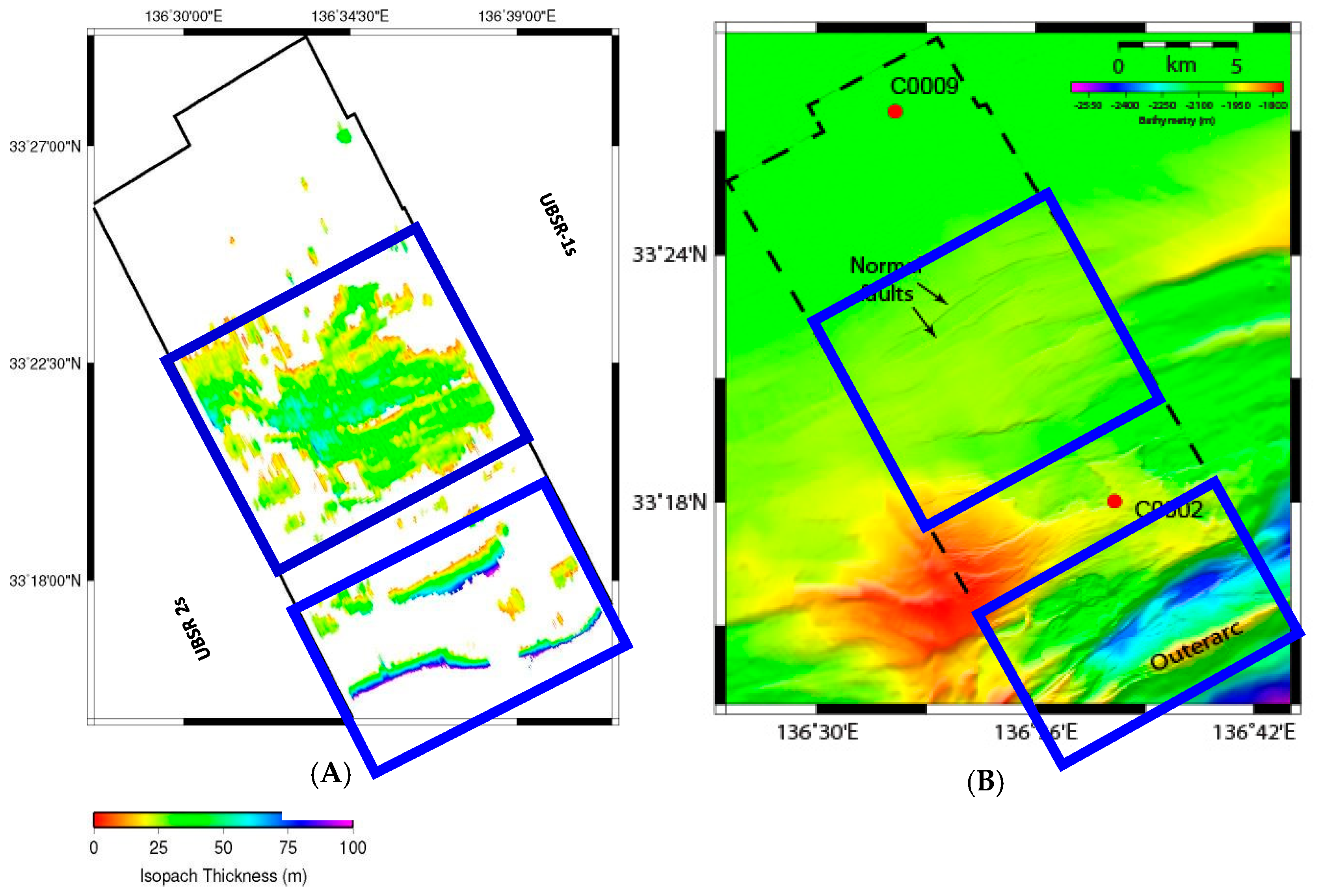

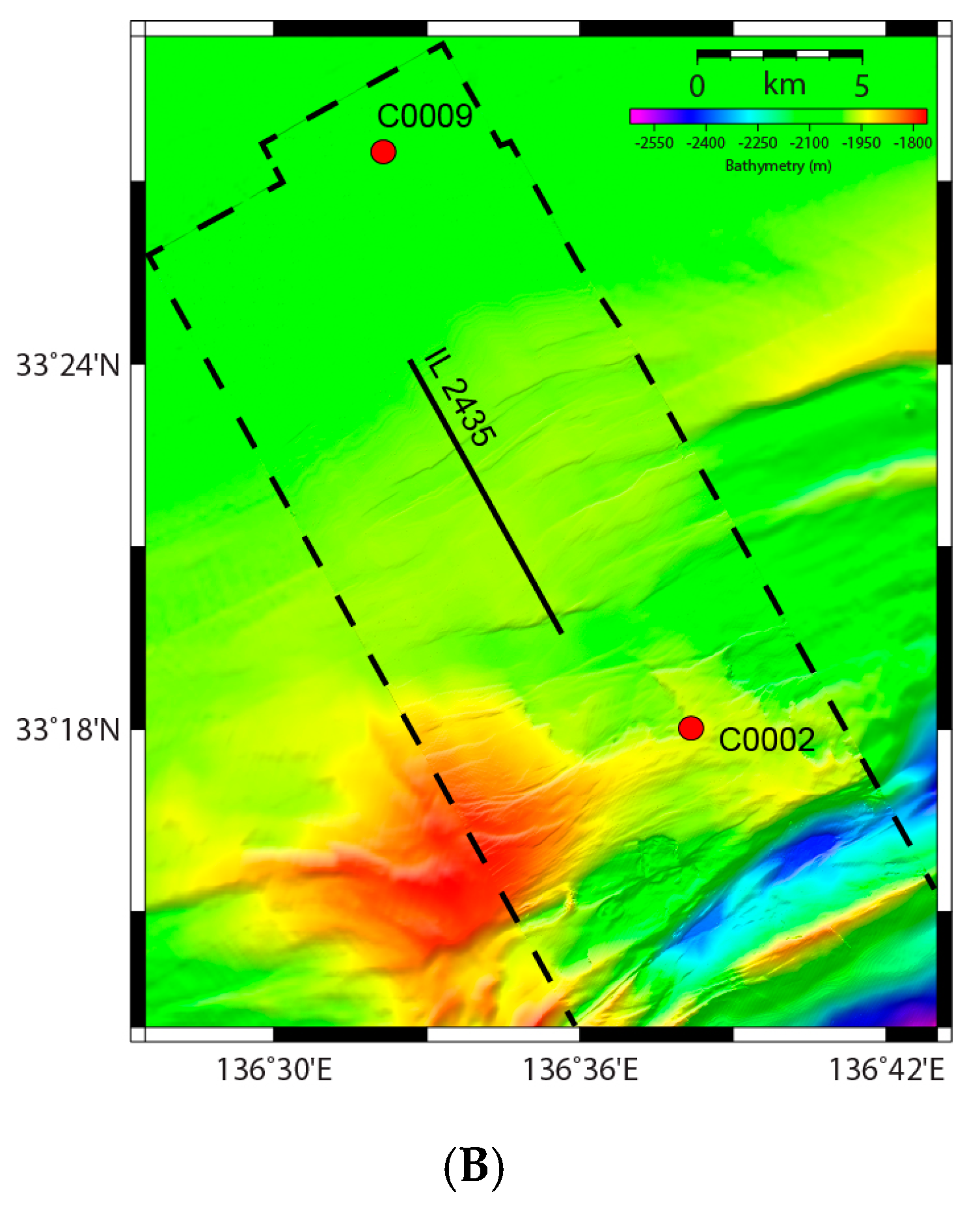
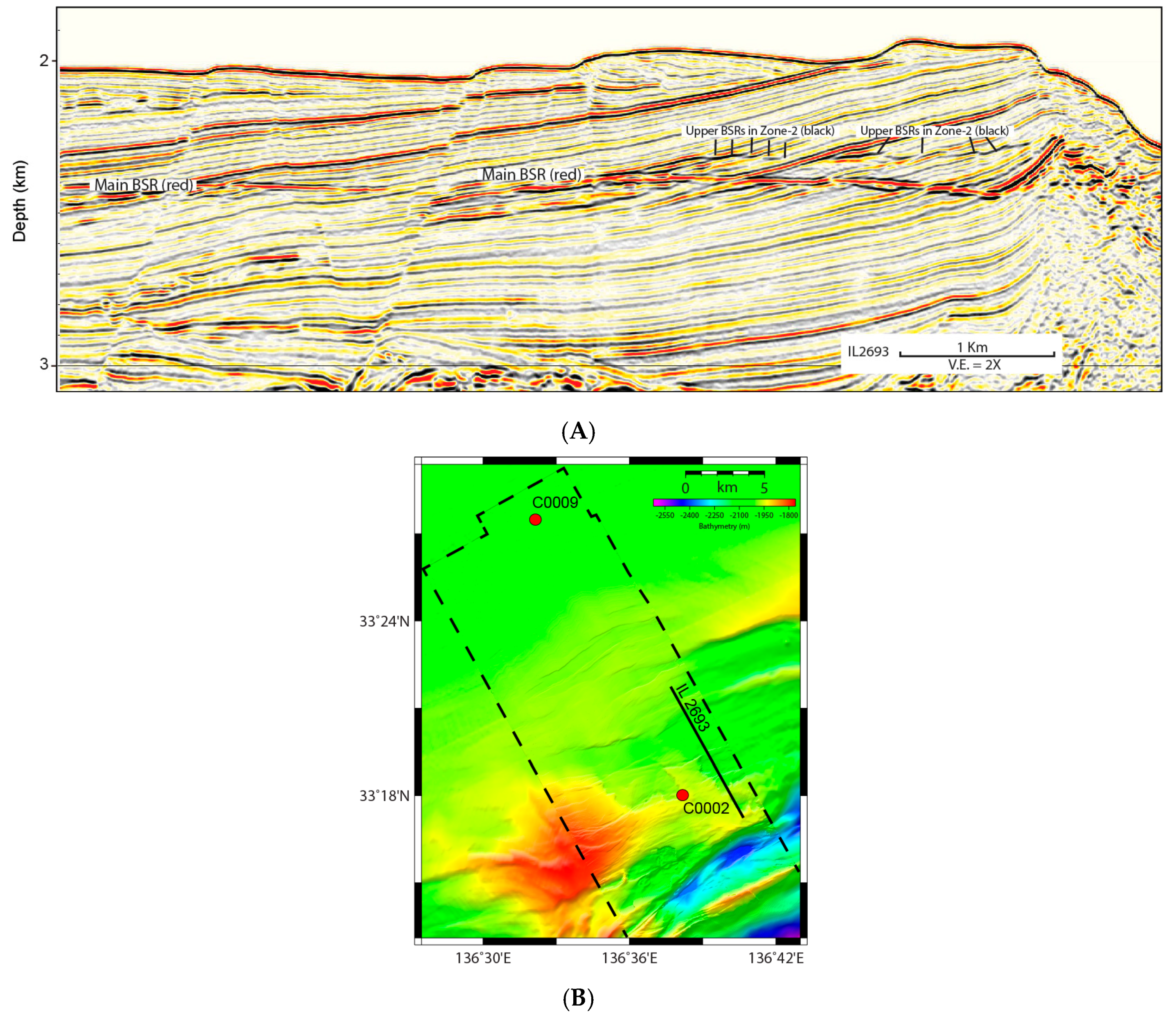
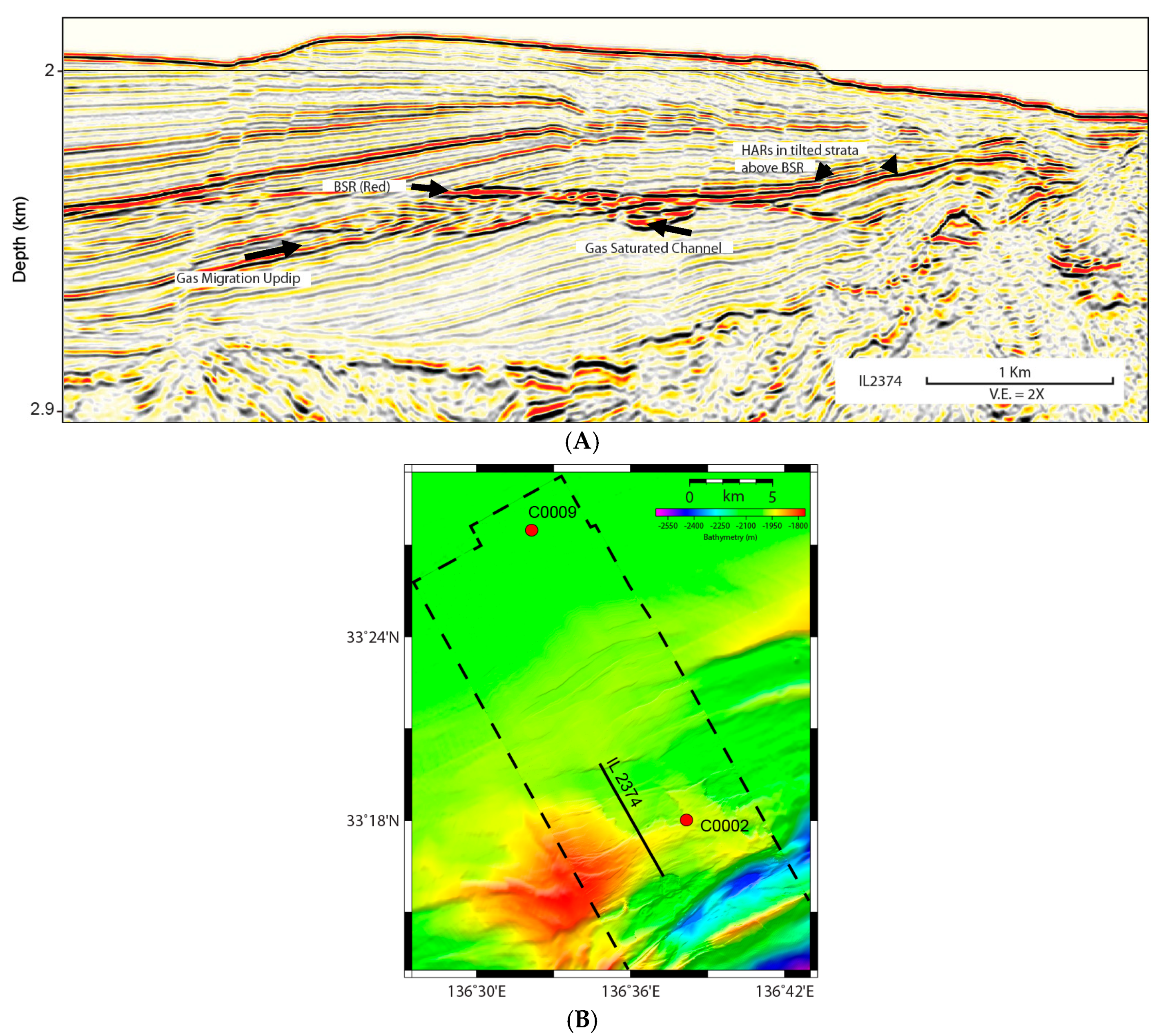

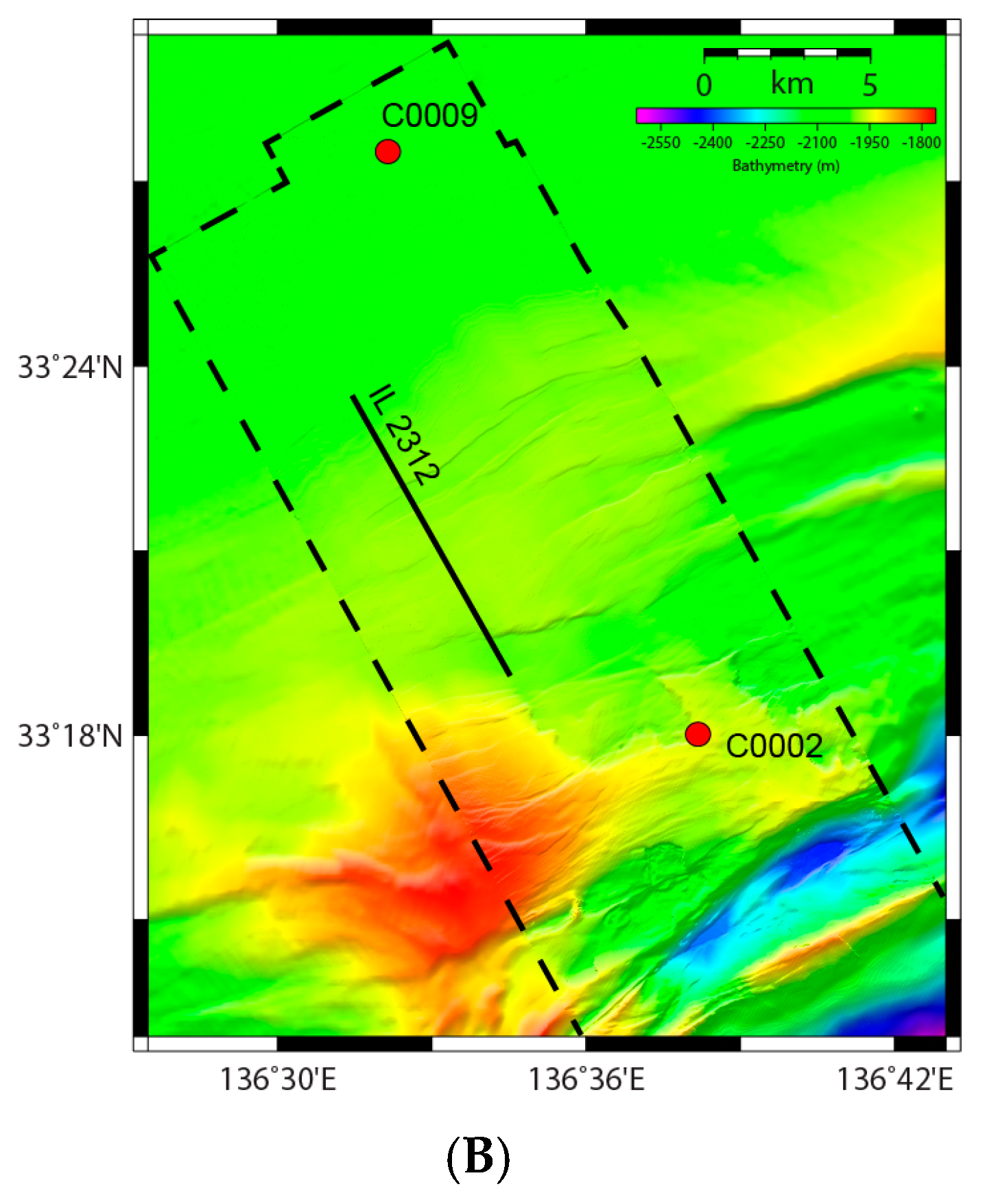
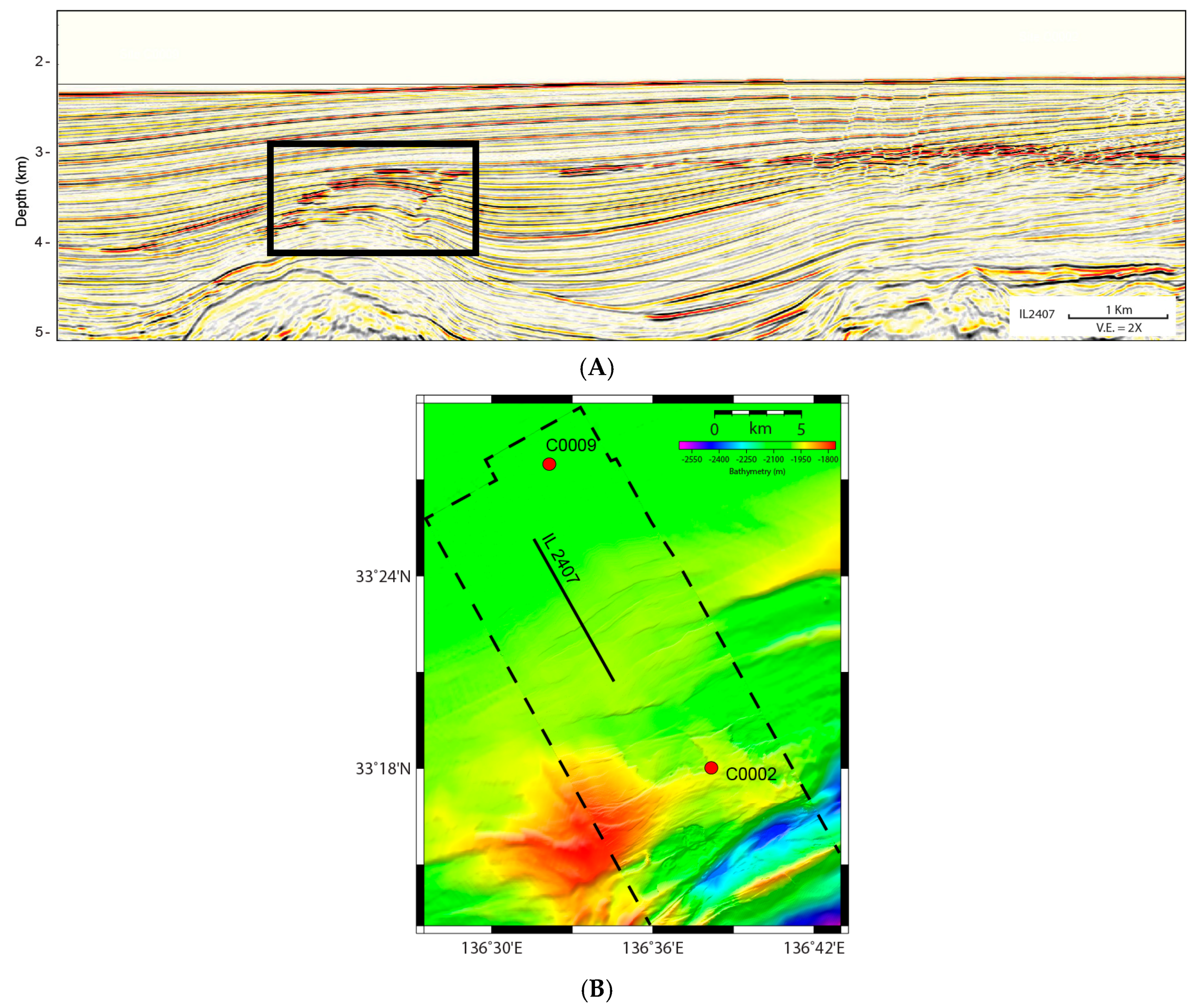
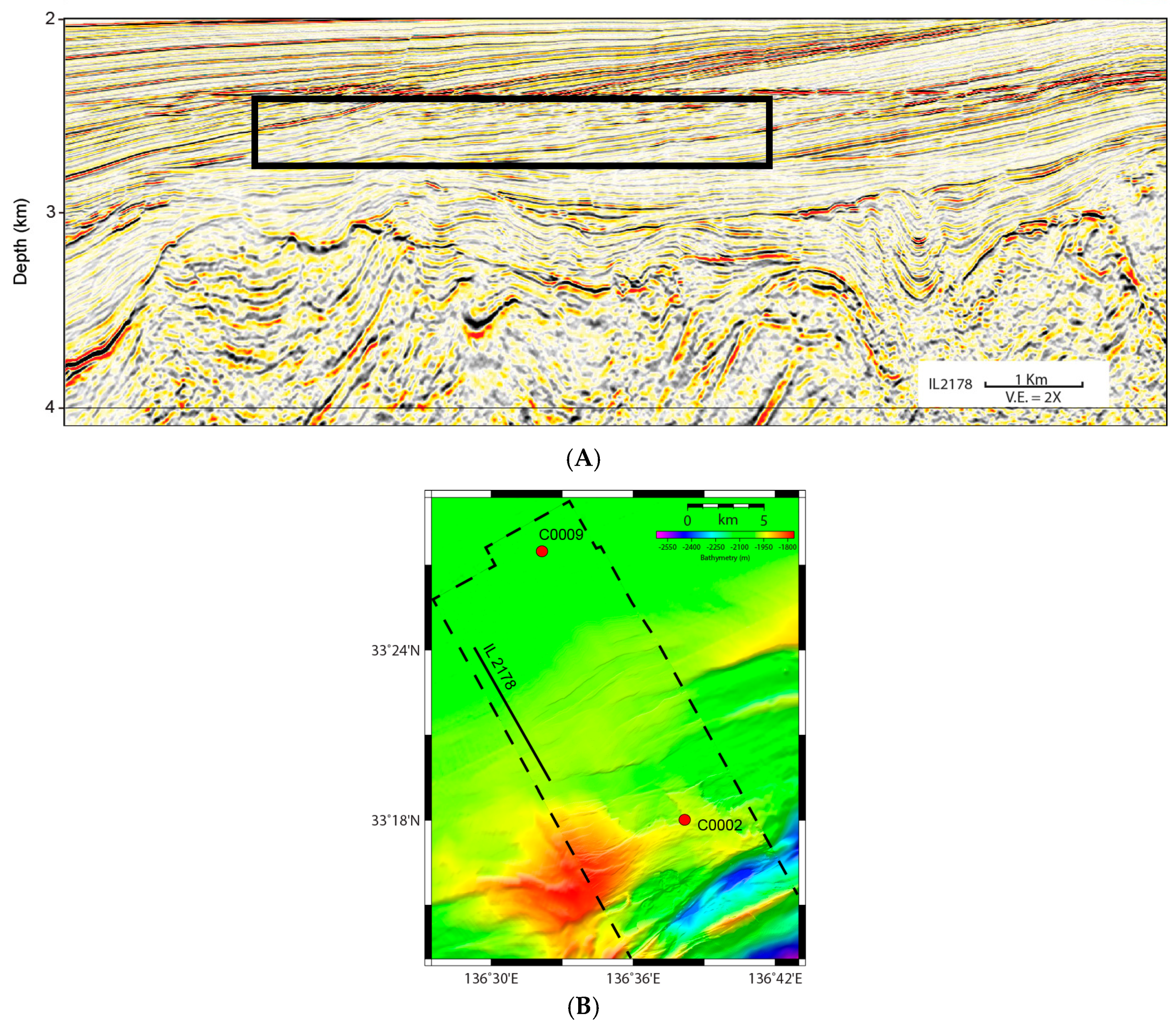
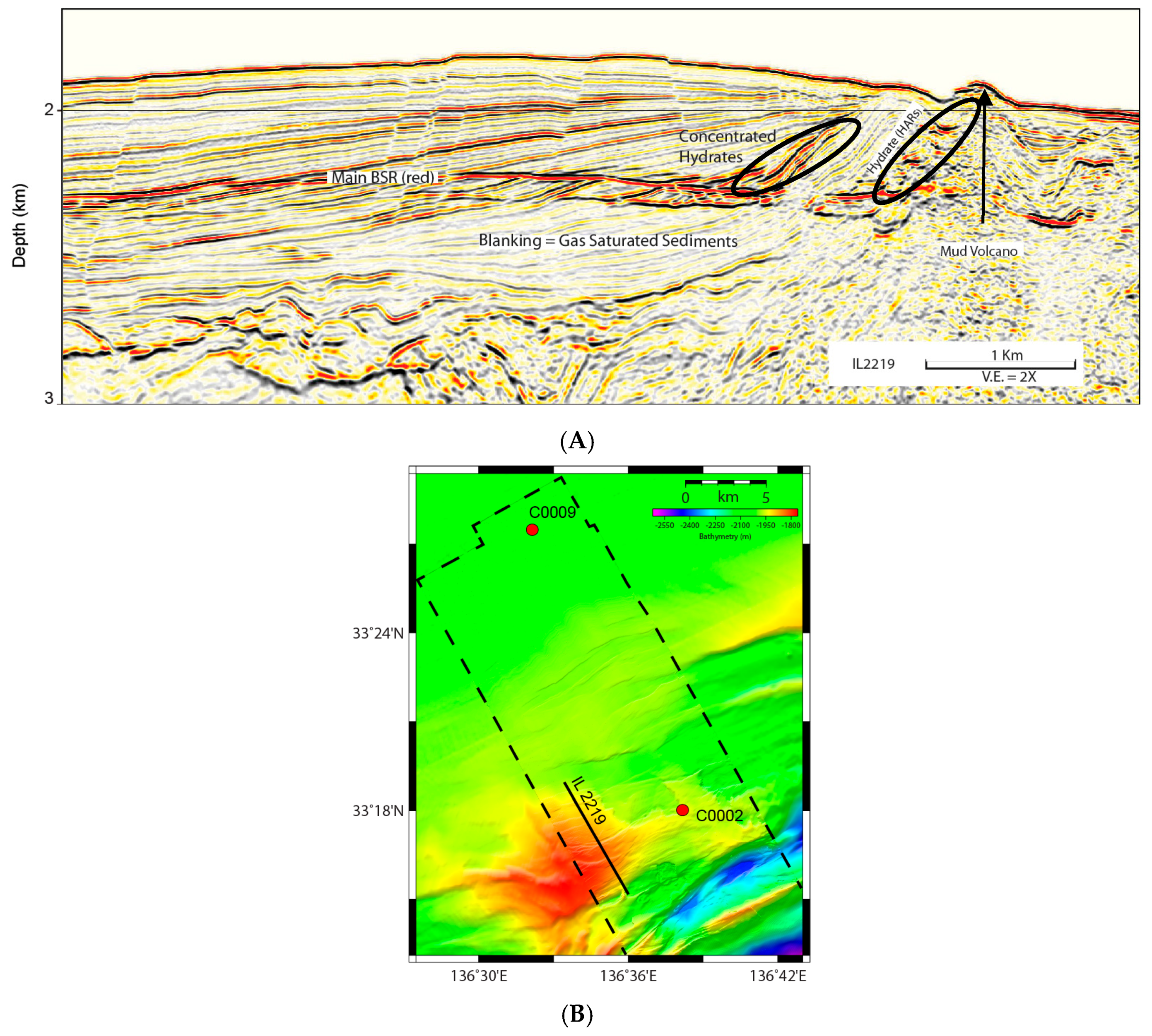
| Parameters | GRV (MMcf) | N/G (%) | Φ (%) | MHSh (%) | VR | CO (%) | GIP (Trillion ft3) |
|---|---|---|---|---|---|---|---|
| Minimum | 955,940 | 0.30 | 0.45 | 0.10 | 164 | 0.90 | ~1.9 |
| Preferred | 955,940 | 0.60 | 0.50 | 0.35 | 164 | 0.96 | ~15.8 |
| Maximum | 955,940 | 0.70 | 0.60 | 0.71 | 164 | 0.99 | ~46.3 |
© 2017 by the authors. Licensee MDPI, Basel, Switzerland. This article is an open access article distributed under the terms and conditions of the Creative Commons Attribution (CC BY) license (http://creativecommons.org/licenses/by/4.0/).
Share and Cite
Taladay, K.; Boston, B.; Moore, G.F. Gas-In-Place Estimate for Potential Gas Hydrate Concentrated Zone in the Kumano Basin, Nankai Trough Forearc, Japan. Energies 2017, 10, 1552. https://doi.org/10.3390/en10101552
Taladay K, Boston B, Moore GF. Gas-In-Place Estimate for Potential Gas Hydrate Concentrated Zone in the Kumano Basin, Nankai Trough Forearc, Japan. Energies. 2017; 10(10):1552. https://doi.org/10.3390/en10101552
Chicago/Turabian StyleTaladay, Katie, Brian Boston, and Gregory F. Moore. 2017. "Gas-In-Place Estimate for Potential Gas Hydrate Concentrated Zone in the Kumano Basin, Nankai Trough Forearc, Japan" Energies 10, no. 10: 1552. https://doi.org/10.3390/en10101552





